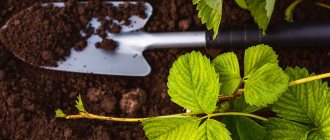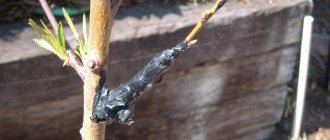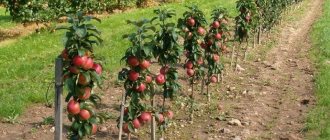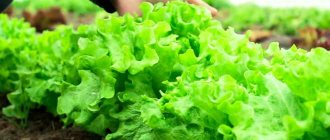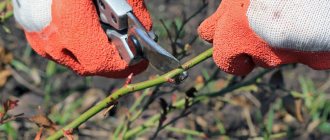Features of grape grafting
To graft grapes, you will need:
- Scion. This is a bud or cutting grafted onto a rootstock. The varietal qualities of the berries and the yield depend on the scion.
- Rootstock. This is the base on which the graft is grafted. It is the rootstock that determines how frost-resistant and hardy the grape bush will be. It also affects some characteristics of the fruit and the plant's immunity. The purpose of the rootstock is to provide nutrition and growth.
The main thing that a gardener must learn when starting grafting is that not all scions take root on rootstocks. There are varieties that are incompatible. But, as a rule, they learn about incompatibility (affinity) experimentally.
There are different types of vaccinations:
- Green. These include procedures carried out from spring to autumn. From the awakening of leaves to their falling. Types of green grafting: standard;
- to the root;
- green to green;
- black to black;
- black to green.
Summer vaccination
Summer grafting of grape bushes is carried out in June or July. Cuttings prepared in the fall are used. They are cut from below in the form of a wedge of two centimeters in length. Before grafting, they are placed in water until the buds open. You can add a growth stimulator at the end, for example, Gumiam or Epin.
It is best to transfer the cuttings to the grape bush in the morning or evening so that the cuttings are not exposed to the scorching sun. A cut is made on the vine 2-3 centimeters deep, and a scion is inserted there. The knives used to make cuts must be clean; they can be disinfected with alcohol or potassium permanganate. The structure is tied with a rope or cloth, coated with clay on top and wrapped with plastic film. It should be attached above and below the grafting site.
In summer, you can use not only the standard black grafting, but also green. How to graft grapes with a young branch? To do this, take a fresh green vine and select the same rootstock on the bush. The tips of the cuttings are sharpened in the form of a wedge, and a cut is made on the branch. The young scion is inserted into a cleft in the grapevine, wrapped with twine, covered with clay and covered with polyethylene. Summer grafting with a green cutting is good because the scion does not need to be prepared in advance. The engraftment rate is quite high. No lower than in cases where a black branch is used.
Pros and cons of the procedure
By grafting grape bushes, gardeners receive several benefits at the same time:
- Grapes grafted onto a rootstock that are resistant to phylloxera, the most dangerous pest of grapes, develop lasting immunity.
- The ability to quickly grow a maximum of grape varieties and hybrids on a limited area. There is no need to dig up old bushes and plant young ones - you can get a harvest faster.
- In weakly fruiting bushes, the yield increases after grafting.
- If a bush has completely lost its shoots - due to frost, damping off, or damage by rodents - it can be restored in several seasons.
- Inaccessible and valuable varieties are quickly propagated by grafting.
- The use of frost-resistant rootstocks increases the variety's resistance to frost.
- The tolerance of demanding varieties to unfavorable conditions increases. Grafted onto a stable and hardy rootstock, capricious varieties can grow safely in acidic, calcareous soils, as well as in areas with high groundwater levels.
- By grafting varietal cuttings onto the rootstock of an early and early ripening variety, fruit ripening is accelerated. This is especially beneficial for areas with short summers.
- It is allowed to graft several varieties onto one root - family bushes are created. This is both economical and decorative.
- By combining the variants of rootstocks and scions, they influence the characteristics of the fruit - size and taste.
The root system is the most valuable thing in old grape bushes. It is not advisable to uproot them - they can serve as the basis for growing other varieties.
Preparation and storage of scion
To obtain a high-quality scion, cuttings (chubuks) are prepared in the fall. Harvesting occurs in October-November, before the onset of frost. For grafting to be successful, the cut of the cutting must be perfectly even. Before performing the procedure, it is advisable to practice cutting off unnecessary branches.
Do not use the upper part of the shoots - about 30 cm - as cuttings; also avoid fattening, damaged, immature, crooked and thin shoots.
Cutting parameters:
- The shoot diameter is at least 8 mm.
- The minimum number of eyes is 2-3 pieces.
- Average length – 9-12 cm.
- The mustache, the shoot with which the grapes cling to the support, should fall off at the lower node. A node is the location of leaves, inflorescences, buds and tendrils. A fallen mustache indicates the maturity of the cutting and increases the chances of its survival. The node selected is developed and lignified.
- If you plan to graft several scions onto one root at the same time, they must have the same cross-section.
To harvest the scion, use only healthy bushes that have been bearing fruit for at least 3 years.
Harvested cuttings must be properly prepared for storage:
- Disinfect by immersing 3% copper sulfate in copper sulfate for 30 seconds.
- After drying, the cuttings are wrapped in polyethylene or wet cotton cloth and stored for storage. The storage location can be the bottom shelf of the refrigerator or the cellar. In the latter they can be stored in boxes with sand or sawdust. The optimal storage temperature is from -2 to +2°C.
Mistakes gardeners make when grafting grapes
It is unacceptable during vaccination:
- for cutting cuttings, use the upper part of the vine;
- use crooked and damaged shoots, low-quality, dried cuttings.
In order for the cutting to take root well, it is necessary to choose a rootstock variety that is equal in strength to the scion variety.
Viticulture requires gardeners to have certain knowledge and, when carrying out grafting, skills. But you can learn everything and get the desired result. The main thing is to strictly follow the instructions described above.
Rootstock selection and preparation
It is better not to take very old bushes as a rootstock. The best option is plants between 3 and 5 years old. Scions take root better on such bushes.
Characteristics of a good rootstock:
- high frost resistance;
- vigorous bushes;
- disease resistance;
- well developed underground trunk.
The rootstock is also prepared for grafting - from spring to autumn. A few days before the procedure, the bush is fed. Use foliar fertilizers. Preference is given to drugs containing potassium and phosphorus. Many gardeners feed the vine with honey - it is spread on the branches a few days before cutting.
A week before vaccination you also need to:
- Cut off the young shoots, tendrils and leaves growing from the bottom to the site of future grafting on the rootstock.
- Water the bush abundantly, which will serve as a rootstock.
Grafting methods
There are several methods of vaccination. There is nothing complicated in this procedure. The main thing is to study the execution technique and follow it exactly. All of the methods discussed below provide high survival rates.
In standard
The good thing about this method is that you can simultaneously graft two different varieties onto one standard. Each cutting should have three buds, no less. Vaccination procedure:
- Dig the trunk to a depth of 30 cm. The width of the hole is 50 cm. Having determined the grafting site, make a cut in it - perpendicular to the trunk.
- Clean the cut with a knife, removing rough edges.
- Use a rag to remove old bark, dirt and sawdust.
- Split the stem along the largest cut diameter. The depth of the split is 2-3 cm. Insert a wedge, such as a screwdriver, into the split.
- Prepare the scions - make cone-shaped cuts 2.5 cm long on the cuttings. Make the cuts 5-7 cm below the lowest eye.
- Place the cuttings in water. Then dip the cuttings in a growth stimulator (gumiam or another) for 7 seconds.
- Insert the cuttings into the stem so that their outer parts match. The bottom peephole should look outward.
- Remove the wedge and seal the gap between the scion and rootstock with paper. Place plastic film on top and tie the stem around it.
- Coat the trunk with clay without touching the scions. This will save the standard and grafting from the cold in winter.
- Sprinkle the grafting site with soil and cover with a cut plastic bottle.
See how to graft grapes into a bush:
Into the cleft
The method is usually used for “black to black” grafting in March-April. The scion is taken from a thick branch with dark bark. It is cut off at a distance of 5 cm from the node. Operating procedure:
- A couple of days before grafting, remove the cuttings from the storage location. Sharpen the lower end to a height of 3-4 cm. Soak in a stimulating solution.
- Dig up the bush trunk and clean it of bark.
- Make a split in the center of the trunk - a longitudinal cut 3-4 cm deep. The cutting tool must be sharpened.
- Insert two cuttings into the split from different sides. Secure the graft with rope and cover with clay mortar.
- Treat the grafting site with garden varnish. Sprinkle sawdust on top, then soil.
Half-split
This method works similarly to the previous one. The difference is in the number of grafted cuttings. Grafting into a cleft is carried out following the scheme “2 scions for one rootstock”, and for a half-split – “for one rootstock - one scion”. Vaccination time is March-April.
Drilling
Grafting by drilling is even simpler than grafting into clefts. The method is characterized by high survival rate of scions. Vaccination procedure:
- Remove the cuttings from the cellar. Wrap them with damp cloth. Let them sit at room temperature.
- Remove 0.5 cm of bark from the ends of the cuttings.
- Find a drill the same diameter as the scion. Disinfect it in potassium permanganate.
- Drill a hole 4-5 cm deep in the center of the trunk.
- Insert the scion into the hole. Cover the graft with clay mortar.
To increase the likelihood of survival, drill several cuttings onto one trunk at once.
Copulation
For direct copulation, cuttings of the same diameter are selected. They are soaked for 2 days in water. How to proceed:
- Make an oblique cut on the rootstock. The length of the cut should be twice the diameter of the trunk.
- Make a cut on the scion of such size that it exactly matches the cut on the rootstock.
- Connect the scion and rootstock with sections. Tie the graft with garden varnish.
- Sprinkle the graft with loose soil. If the grafting is done correctly, after a while a sap will appear at the top.
Sap is a liquid that is released from damaged wood.
Butt budding
This is the best way to vaccinate in the spring. Provides a high survival rate. The method is especially suitable for areas with high humidity.
The procedure for grafting into the butt:
- Remove the shoots and foliage from the vine to the rootstock.
- Make the cutting wedge pointed and tetrahedral.
- On the rootstock on the sides of the trunk, make corner cuts that match the size of the scion wedges.
- Attach a wedge of cuttings to the cut on the rootstock, tie with twine and treat with garden varnish.
Vaccination is carried out from the end of May to the beginning of July. Woody cuttings are grafted in the spring, and green cuttings are grafted in the summer.
Back to back
This is an underground grafting that is very easy to do in the spring:
- Dig the rootstock 10 cm deep. Clear the rootstock of soil.
- Cut the trunk at a depth of 5 cm. Select the drive and rootstock so that they are perfectly even and of the same diameter.
- Insert a thin wooden dowel into the middle of the rootstock, perpendicular to the ground. Place a scion on top of it - in this way the scion and rootstock will be held together.
- Wrap the grafting site with cotton wool moistened with potassium permanganate and then with paper.
- Fill the hole with wet sawdust and cover the top with plastic wrap or a bag.
On an old bush
Grafting onto an old bush allows you to get a harvest earlier than if a young seedling were planted. The grafted bush begins to bear fruit after 1-2 years. It is advisable to harvest cuttings in the fall. Any variety can be grafted in this way.
The procedure for grafting onto an old bush:
- Dig a hole near the rootstock bush. The depth of the pit is 20 cm. Completely remove the above-ground part. You can graft from 1 to 4 scions onto the trunk remaining after pruning the bush.
- Sharpen the cuttings into a wedge shape. Side – 2 cm, sharpening angle – 20-30 degrees.
- Split the stem with a knife 3 cm deep. Insert cuttings around the edges. To plant 4 cuttings, the diameter of the trunk must be 7 cm or more. Make 2 splits for this number of cuttings. Insert 2 scions into each.
- Tighten the grafting site. Fill the hole near the trunk with soil and water it generously.
To the root
Grafting into a skeletal root is chosen if the underground trunk is very short and it is not possible to make a high-quality split. The rootstock is the skeletal root of the trunk. It is separated from the trunk and fixed by tying it to a small support. You can graft a cutting into the root using any of the methods described above - in a split, half-split, and others.
Re-vaccination
Inexperienced gardeners, dissatisfied with the taste of the grapes, dig up the bush and plant a new seedling in its place. But this path is impractical. It is easier to re-graft a bush if it is strong and healthy. Then the harvest will be obtained in the 3rd year after grafting.
Re-grafting is done in early spring or late autumn, completely removing the above-ground part of the bush. The cuttings are grafted into a cleft or “black to green.”
Below watch a video about regrafting grapes:
Preparation of cuttings
Cuttings for grafting must be well-ripened and healthy, with hard yellow-brown bark, and also, the vine from which the scion is taken must bear fruit at least once.
The length of the cutting required for grafting is 55-60 cm, and the diameter is 7-14 cm. The scion must have at least 2 buds.
Cuttings for grafting must be well matured and healthy
In order to prepare the cuttings for autumn grafting, they are waxed. As a result of this, it will withstand the winter cold without problems. A layer of paraffin will retain the required amount of moisture in the rootstock and help it take root well.
Before covering the cutting with paraffin, it is soaked in an aqueous solution of heteroauxin, which is a growth stimulator. This scion will take root faster and grow.
Paraffin is prepared as follows:
- put it in a container with water;
- bring to a boil. The melted paraffin will remain floating on the surface of the water.
The cuttings, along with the buds, are dipped in hot paraffin for a couple of seconds and then cooled in cold water. The scion must be well dried, otherwise the paraffin will not stick to it. This operation should be performed as quickly as possible so as not to damage the cuttings.
Then the bottom of the cutting is cut off in the place where it will be grafted. The cut is made at an angle, 3-4 cm, so that the first bud from it is at a distance of 1.5-2 cm.
The scion cutting tool must be disinfected. It is necessary to maintain complete sterility so that the grafted plant does not become infected.
Vaccination at different times of the year
The time of year affects not only the survival rate of the scion, but also the choice of grafting method. Grapes can be grafted in any season, even in winter. In this case, different methods are used.
Spring
Grape growers prefer to graft grapes in the spring. The vaccination period is April-early May. They focus not so much on numbers, but on the temperature and condition of the bushes. Vaccinations begin after the start of sap flow - at this time the highest survival rate.
Features of vaccination in spring:
- it is protected from the sun and frost if the scion begins to grow earlier than the rootstock;
- To activate sap flow, the bushes are watered abundantly several days before grafting.
In the spring, a procedure called “black to black” is carried out. Both parts - the scion and the rootstock - are in the initial stage of bud break.
The grafting is carried out with cuttings prepared in the fall. Using this method, individual shoots of the bush and grown rootstocks are grafted.
How grapes are grafted in spring is described and shown in the following video:
Summer
In summer, grapes are grafted in June or July. The advantage of summer grafting is the possibility of cutting cuttings right before the procedure. You can graft using any of the methods – “green to green” or “black to green”.
Conditions for vaccination:
- overcast weather;
- temperature up to +25°C;
- lack of precipitation;
- before 10 am and after 6 pm.
Green to green grafting is used in the summer. It does not require the preparation of material in advance. Cuttings are immediately grafted onto the rootstock. Most often, by copulation.
In summer you can also plant cuttings prepared in the fall. A new cut is made on them, which should go lower than the lower bud. The cuttings slept for a long time, so they are activated by immersing them in Epin’s solution for 15 minutes.
The rootstock is prepared by making one cut on the shoot, the second - in the middle of the first. The scion is inserted into the socket so that the eyes of the scion and rootstock look in different directions. The vaccine is secured. Using a similar technology, they graft “green onto green” - only in this case there is no need to soak the scion.
Autumn
In the fall, grapes are usually grafted onto old roots using one of two methods - in a split or in a standard. This approach allows you to revive old bushes, increase productivity and get a harvest within a year.
Conditions for vaccination and features of its implementation in the fall:
- Temperature not less than +15°C. The vaccination period is October-November.
- The clusters are completely harvested, the leaves should turn yellow.
- The cuttings are kept in a growth stimulator 2 days before the procedure, and then grafted using any suitable method.
Winter
Tabletop vaccination is carried out in January-March. One- to two-year-old bushes are used. Scion cuttings are prepared in the fall in the usual way. Winter vaccination procedure:
- Late in the fall, when all the foliage has fallen from the bush, dig up the bush completely. Trim the bush, leaving a 10 cm trunk.
- Disinfect the cut in a weak solution of potassium permanganate.
- Place the rootstock in a box with wet sand. Sprinkle with sawdust and store in a cellar at zero temperature.
- The day before the procedure, remove the rootstock from the cellar. Clean, check the roots, cut off the damaged ones completely, and cut off the healthy ones to 15 cm. Move the bush to a room with a temperature of 18-20°C for several hours.
- When the bush warms up, immerse the roots in water at a temperature of 15°C for a day.
- Dry the roots with a cloth, and then graft the cutting using any of the methods described above.
- Place the grafted bush in some container and cover with plastic wrap. Let it sit for several weeks in a warm place.
- After 2-3 weeks, move the bush to the cellar - let it wait for spring.
- In the spring, after the temperature reaches 15°C, take the bush outside for hardening. Start it with several hours, gradually increasing the intervals. After 2-3 days, plant the bush in the ground.
In this video, the gardener shows in detail how he does home, desktop, winter grafting of grapes:
Vaccination dates
What is the most optimal time for grafting grapes? Every newbie asks this question. Most winegrowers believe that it is best to do this during the most intense movement of juices in the stems (pasok). This time occurs approximately in the middle of spring, before the swelling of the buds. Spring grafting of grapes has the highest percentage of grafting of cuttings, almost all of them produce young pagons.
You can also graft grapes in the summer. The best time for this is the end of June or the beginning of July. The movement of juices in the vine is still intense. By the end of the season, the scion takes root. Summer vaccination is carried out in not very hot, but not cloudy weather. You can't do this on a rainy day. Summer grafting is not just a matter of chance. A green branch can be used as a cutting. It is grafted onto the same rootstock as the black one.
It is allowed to graft grapes in the fall, after they have been pruned. They do it from the end of August to October, until the air temperature drops below 15 degrees. In the fall, grapes are grafted onto a standard, although this can also be done in splits. It is best to use old bushes with a well-developed root system. Already in the spring they will accelerate growth and their yield will increase.
Annual or biennial grape bushes are grafted in winter or early spring. To do this, use the tabletop grafting technique. The rootstock is taken out of the ground and cleaned of rotten roots. The vaccination is done indoors. When the temperature outside rises to 15 degrees, the grape bush is planted in the garden. Winter grafting allows you to save almost all young grape bushes.
Caring for grafted grapes
The survival rate of the vaccination depends not only on the correctness of the procedure, but also on further care. How to care for a grafted bush:
- For a whole year after grafting, loosen the earthen hill around the seedling.
- 30-40 days after grafting, remove the soil from one side and clean the roots that appear on the cuttings. Trim them. It is necessary that the scion and rootstock grow together into one whole. After cutting off the roots, fill the hill with soil.
- Trim emerging growth from time to time.
- Spray the shoots with Bordeaux mixture every 10 days. First with a 0.5% solution, and then with a 1%.
- If there is little rain in the first half of summer, moisten the soil every week.
- If the soils are poor, fertilize. Fertilize the soil no more than three times per season.
- To prevent damage to the connection, attach shoots longer than 40 cm to supports or a trellis.
- When the shoots become woody - in August, remove the earthen mound near the grafted bush.
For proper distribution of nutrients, prune the shoots for 4 years.
Why vaccinate, benefits of vaccination
After grafting (spring, summer, autumn), it is imperative to water the rootstock and thoroughly hill up. To saturate the tree trunk with oxygen, loosen the soil. There is no need to cover the joint with soil if the grafting was carried out in a split stem.
After a two-week period, if buds do not appear on the grafted cuttings, it is necessary to cut off the upper part of the rootstock and graft a new cutting again. The fusion of the grafted area should be checked every 10-13 days. The roots that the cuttings have not sprouted into the rootstock must be removed, because the result will not be a graft, but a new plant.
During the growth of grafted grapes, weeds should be destroyed in a timely manner and the soil around them should be loosened. It is necessary to loosen the soil regularly to prevent the formation of a crust that appears after watering or rain. Cover grafted grape bushes with straw or spruce paws in the fall before the first frost.
Beginners should be more careful when choosing a grafting method. Ideally, first see how someone with experience does it. The success of grafting depends not only on the chosen variety and the correctly performed procedure, but also on subsequent care. Ignoring this rule may result in all your efforts being in vain.
If the vineyard was damaged during the winter, it is possible to restore the entire above-ground part of the bush by grafting within one or two seasons.
Grapes are grafted for the following purposes:
- obtaining new grapes in a short time for partial replacement of plantings;
- complete change of variety;
- increase in yield;
- propagation of the variety you like.
Three days before working with the vine, you need to start watering the grape bush well
For a successful result, you must follow several basic rules for grafting grapes in the spring:
- Determine the right time to implement your plans.
- Prepare excellent grafting material. Treated and carefully preserved cuttings of autumn pruning usually tolerate grafting more successfully.
- Use mature rootstock, at least three years old.
- Carry out vaccination care throughout the current year.
The success of the procedure can only be said after 30–40 days, when the scion sprouts
A necessary condition for the development of successful vaccination is careful care, which involves:
- creating optimal conditions for growth and development in summer and autumn;
- timely watering, mulching, feeding with potassium and phosphorus;
- exclusion of nitrogen fertilizers, especially in autumn;
- protection against breakage and damage;
- at the end of summer, pinching the top for ripening;
- regular loosening of the soil in the hole to enrich it with oxygen.
- preservation of the scion and rootstock in the first winter.
Accuracy in work is the key to a good harvest
The most common mistakes for novice winegrowers when grafting are:
- the grafting hole is too deep;
- incompatibility of scion and rootstock;
- improper storage of cuttings;
- lack of a tight fit, and as a result, rotting and death of the scion;
- use of unsuitable tools and materials, lack of a sharp knife, disinfectant and materials that help prevent the flow of juice (paraffin, plasticine, cling film).
Accuracy and attentiveness will help to avoid mistakes and failures when grafting grapes in the spring, then very soon even novice gardeners will be able to please themselves and their loved ones with delicious grapes of different varieties from one bush.
| Method of care | Description, stages |
| Seedling protection | Coat the grafting site generously with liquid clay, forming a cone. Add soil in a layer of about 10 cm, without covering the edges of the cuttings. Place a greenhouse over the graft (5 liter plastic bottle or spunbond tent). In spring, the shelter is periodically removed during warm weather to acclimate the seedlings to the surrounding temperature. Remove the greenhouse at an air temperature of 15 ºС. |
| Good development of seedlings is ensured by fertilizing. | Organics and complex mineral compositions are used. Prepare an infusion of mullein (1:10). Dilute with water (0.5 liters of infusion per bucket of water). A bucket of fertilizer is poured onto one bush. Mineral fertilizers are prepared according to the instructions. |
| Watering | Regularity – once every 7 days, taking into account weather conditions. Water for irrigation is heated to 24 ºС -28 ºС. Water the bush around the perimeter of the hole, protecting the grafting from water. Dose – 20 liters per bush in spring; after a month, watering is carried out after 2 weeks, then after 20 days. It is optimal to carry out drip irrigation for grafted grapes. |
| Autumn moisture-charging irrigation. | A necessary operation for grafted grapes to protect the ground from freezing. |
| Bush formation | In the spring, after grafting into the cleft, with strong plant growth, accelerated formation is carried out: Pinch the sprout after the 4th leaf. Shoots from the stepsons continue to form for 2 years, restoring the above-ground part of the grape bush. Spray young shoots that appear above the soil surface with Bordeaux mixture, first 0.5%, second time 1%. Spraying is done after rain. Regularity should not exceed 12 days. |
Read more: Grapes before flowering, how to treat them, care, spraying, pinching
Start caring for grapes as soon as you see signs of successful grafting.
The depth of the pit is maintained below the soil freezing mark. It ranges from 80-100 cm, but this depends on the region and terrain conditions. A layer of sand should be poured onto the bottom of the hole, then the cuttings tied in bunches should be placed vertically. Sand is poured into the cracks between the beams. The same pillow is made between the walls of the pit and the beams, as well as a layer of sand on top.
Question No. 2. How to properly wax purchased grape cuttings?
On purchased cuttings of valuable varieties, renew the cuts and soak in a vertical position. Air dry. This is important if you received the material by mail. Then both sections are dipped in paraffin, the temperature of which should not be high so as not to burn the cuttings. They take special paraffin for vaccinations, not medical paraffin. You can replace it with a composition of wax, regular paraffin and garden wax (1: 1: 0.5).
When storing cuttings for grafting for a long time, use the waxing method.
Question No. 3. Why is a grafted grape bush more profitable than a self-rooted one?
Some grape varieties have great flavor but are unable to withstand disease or cold temperatures. And a hardy variety does not always produce tasty fruits. Grafting helps to combine the qualities of the rootstock and scion. A correctly grafted bush is stable, has strong growth, produces an early harvest, and saves space in the garden.
Question No. 4. The roots of the cutting protrude from the grafting site. What to do with them?
Remove, otherwise the cutting will take root on its own and not through the rootstock.
Inexperienced gardeners, when grafting grapes, make typical mistakes:
- They buy cuttings that will be grafted at the market from strangers. When a shoot is prepared incorrectly, it will not take root on the grapes and the owner will waste time and energy, but will not get any results.
- They want this season to have both harvest and grafting. They take pity on the rootstock bush and cut it not as required - short, but leaving branches so that it bears fruit.
- For grafting, they take varieties that they have a vague idea about, according to the seller. The branches grow, but do not produce the grapes that the owner would like.
- The shoots for grafting are stored incorrectly, prepared incorrectly and the grafting technology is violated.
- The soil near the trunk is not loosened.
When grafting a cutting or several onto a trunk, a beginner must adhere to a certain technology. It is important to properly prepare the cuttings, soak them in a store-bought growth stimulator or an aqueous honey solution. They are ventilated and pinched correctly, then there is a greater chance that they will take root and the vines will bear fruit.
Bushes that have been grafted are regularly cared for. Every 4-5 days, the soil in the area around the tree trunk is loosened and hilled up to increase the depth to which oxygen, fertilizing and water penetrate. Before making this or that decision, the gardener assesses the condition of the bush:
- Digging is carried out 14 days after the summer resident saw that no shoots had formed on the grafted cuttings.
- The upper part of the rootstock is removed along with the previously made grafting, after which re-grafting is carried out.
- Botanists recommend regularly monitoring how well the rootstock and scion grow together. The check is carried out at least once every 12 days. If roots appear that are not included in the rootstock, they are removed.
- Regularly remove weeds. If weather forecasters promise a sharp cold snap, spruce spruce branches are used as a warming element.
Every 3 weeks, the bushes are treated against fungus. Any solution purchased at a gardening store will do.
Important!
The grafting site is not wrapped very tightly.
Improper storage of cuttings is a common reason why grape grafting fails in summer or autumn. The recommended temperature background is about 5 degrees. Exceeding or lowering the temperature will lead to rapid loss of moisture from the cuttings. The second common mistake is using a scion and rootstock with different ripening periods. The list of gardener’s faults is completed by insufficient treatment of the splinter site. Rot forms in it.
Grapes are grafted to improve the original characteristics of the plant. Grafting is especially important for plants that have average or poor performance.
Vaccination improves the following characteristics:
- Resistance to diseases and pests. For manipulation I use a rootstock with good immunity to powdery and downy mildew, and anthracnose. In addition, grafted shrubs are less susceptible to phylloxera attack. Of course, vaccination is not a panacea for all problems, but infected plants tolerate diseases much more easily than specimens of ordinary varieties.
- Productivity. As a result of grafting vigorous varieties, fertility also increases, since such plants grow very quickly and form many fruiting shoots.
- Compactness. If you manage to graft two cuttings onto the rootstock, you can reduce the space for grapevines.
Common Mistakes
Mistakes due to which the cutting does not take root:
- Due to improper storage of cuttings - non-compliance with humidity, temperature and other conditions. If the cuttings dry out, they will never take root. To be safe, you need to wrap the cuttings in film or dip them in paraffin.
- If the split is made too deep, it begins to rot. Moist air gets inside the crack, which causes rotting.
- If you make the cut uneven, the cutting will not take root. The reason for uneven cuts is a poorly sharpened tool.
Tips for beginners
When getting vaccinated, follow these rules:
- use only clean, disinfected instruments;
- follow the instructions for the selected method exactly;
- In order for the cutting to take root, achieve the closest possible contact between the scion and the rootstock;
- choose a scion with high resistance to diseases characteristic of a particular region;
- choose rootstock and scion with the same growth rate;
- Prepare material for spring grafting in the fall;
- in summer and autumn, use fresh material for grafting;
- cut the cuttings away from you so that the cut is concave;
- cut the vine at right angles to the direction of growth;
- carry out vaccination at a temperature of +15 °C;
- Care for grafted bushes using a special technology - until the cuttings have completely taken root.
Vaccination at first glance seems like a troublesome task, unlike all other agricultural activities. To master the art of vaccination, you will need patience and responsibility - it is important to carry out all activities accurately and on time. But the reward is high - high yield, increased immunity and endurance, as well as new opportunities, discoveries and interesting experiments.
0
0
Copy link
